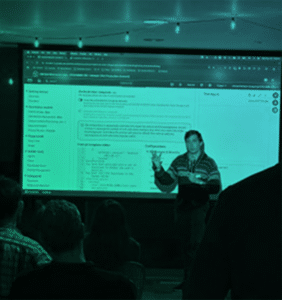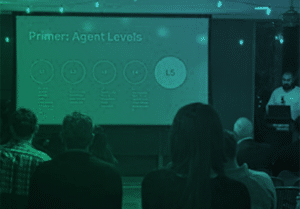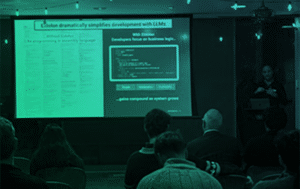By: Andrew McKinzie and Pietro Decio
Date: December 18, 2024
On December 16, Tower Research Ventures hosted an event focused on AI Agents in the Enterprise. Conversations focused on enterprise use cases for AI agents, which are defined as AI systems that leverage language models and display a degree of autonomy. Speakers included Clement Perrot, Senior Solutions Architect for AI at Amazon Web Services (AWS), Mohammed Hayat, Co-Founder and CTO of Abstract, and Ravi Ramachandran, Co-Founder and CEO of Eidolon AI.
The first talk, delivered by Clement Perrot, highlighted new agent tools that AWS has incorporated into its developer suite, encompassing knowledge bases, agents, flows, and prompt management. Amazon Bedrock enables enterprise developers to build a fully customizable knowledge base by specifying the location of their data, selecting an embedding model, and configuring a vector store. Enterprises can also build knowledge bases with a structured data store and the AWS Kendra GenAI Index, which offers out-of-the-box high semantic accuracy and the flexibility to reuse the index across Amazon Q Business and Amazon Bedrock. Leveraging these knowledge bases, developers can then build agents and agentic flows by selecting a foundation model and adding user-defined “action groups.”
During the demo, Clement created an “HR Agent” that automated a response flow an HR coordinator might have with an employee asking questions about their PTO and benefits. The agent was able to respond to a query by accessing the company’s Workday instance, retrieving the employee’s PTO balance, referencing it against the company’s employee handbook, and responding to the employee in natural language. Next, he discussed agent orchestration, which is defined by advanced prompts that specify how the agent processes information and coordinates responses. In addition, he discussed multi-agent collaboration, which enables a supervisory agent to delegate tasks to other collaborator agents.

Clement Perrot discusses the AWS Agentic AI workflow orchestrator.
Next, in his presentation titled “Agents in a Risk-Averse World,” Mohammed Hayat discussed agents in practice. He began with an overview of agent levels L1-L5, with increasing degrees of sophistication and autonomy. L1 agents can perform functions using basic system prompts and fine-tuning, while L5 agents can leverage user profiling and contextualization, memory-driven personalization, and context-switching. He then explained how agents step through a workflow: starting with a prompt, querying a user knowledge base, querying an impacting knowledge base, generating responses with references, decorating those responses with integrations, and streaming them to the end user or another agent. Mohammed also discussed the importance of developers tailoring agents to specific enterprise use cases through a prototype cycle. These cycles typically consist of user profiling to fully grasp an enterprise’s identity through direct client meetings and publicly available data, understanding intent identity to ensure agents act upon that intent, and response structuring so that the agent delivers responses within the enterprise’s parameters.

Mohammad Hayat explains AI agent levels.
Finally, Ravi Ramachandran presented Eidolon AI’s open-source agent SDK and AI agent server for the enterprise. This framework provides a robust environment for creating modular, service-oriented agents that can communicate and work together. Ravi explained how Eidolon’s SDK supports pre-built agents and enables the definition of new agents using simple declarative YAML syntax. This helps developers swap agent components to adapt to changing enterprise requirements without extensive rewrites. Eidolon integrates with Kubernetes, which enables agents to be deployed in a secure and scalable way. It also provides React components to help developers build a GUI to interact with agents. Ravi then provided examples of production use cases with Eidolon, including carrier compliance and delivery scheduling for logistics companies, client custodial statements and capital call validation for fintech companies, first notice claim of loss in insurance companies, and hierarchical multi-agent support systems for managed service providers.

Ravi Ramachandran explains the Eidolon AI open-source server framework.
If you are building in this space, we’d love to chat. Please reach out to Tower Research Ventures at ventures@tower-research.com!
The views expressed herein are solely the views of the author(s), are as of the date they were originally posted, and are not necessarily the views of Tower Research Ventures LLC, or any of its affiliates. They are not intended to provide, and should not be relied upon for, investment advice, nor is any information herein any offer to buy or sell any security or intended as the basis for the purchase or sale of any investment. The information herein has not been and will not be updated or otherwise revised to reflect information that subsequently becomes available, or circumstances existing or changes occurring after the date of preparation. Certain information contained herein is based on published and unpublished sources. The information has not been independently verified by TRV or its representatives, and the accuracy or completeness of such information is not guaranteed. Your linking to or use of any third-party websites is at your own risk. Tower Research Ventures disclaims any responsibility for the products or services offered or the information contained on any third-party websites.